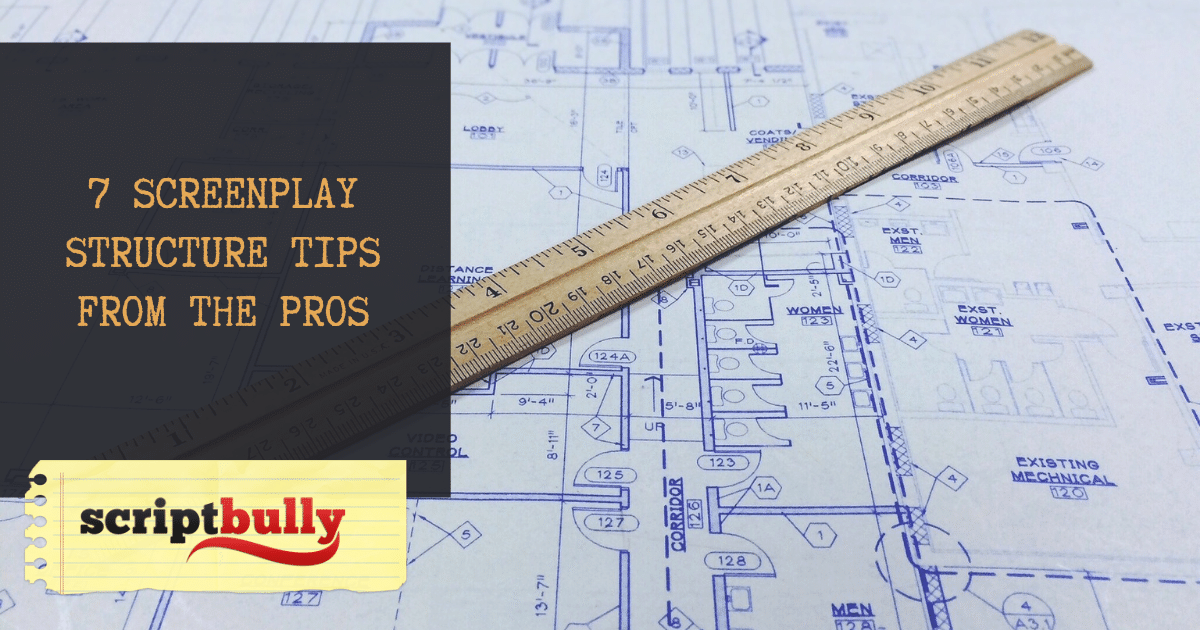Screenplay structure isn’t just ONE of the most important aspects of screenwriting – it is THE most important aspect of screenwriting. It’s the foundation holding together your entire story idea.
Your idea may be fantastic, but an idea AIN’T an entire story. When structured correctly, with the perfect balance of characterization, dialogue, tension and twists, your idea can transform from a few thoughts to screenplay gold. So how do you ensure your structure is sound? Here are a few screenplay structure tips from the pros to keep you on track:
What the Pros Can Teach You About Screenplay Structure
 Tip from the Pros #1: Don’t Turn Your Back on the 3-Act Structure
Tip from the Pros #1: Don’t Turn Your Back on the 3-Act Structure
“Poor old three-act structure. It gets hammered away at, like an old punching bag, every time someone wants to challenge the primacy of the formulaic Hollywood screenwriting methods.”
-Jennine Lanouette – Screenwriting teacher who has taught at Lucas Films, Pixar, and Film Arts Foundation.
Summary: Don’t underestimate the power and importance of the Three Act Structure. Following it doesn’t make your script unoriginal– there are countless ways to make your story new and groundbreaking while still adhering to this structure with a proven track record.
Tip from the Pros #2: Do What Hasn’t Been Done

“Try to make each line AND scene as unique as possible.”
– Jonathan Ames, “Bored to Death” writer and novelist.
http://filmmakermagazine.com/42928-top-10-screenwriting-tips-from-script-to-screen/#.VifnHX6rSUk
Summary: It’s true, with thousands of movies out there and countless stories that have already been told, as a writer you’ll unavoidably be borrowing from other films. The last thing you want to do is create a story that the audience feels they’ve seen before, so do your best to make each individual scene unique.
 Tip from the Pros #3: “Third Act is Your Race to the Finish Line”
Tip from the Pros #3: “Third Act is Your Race to the Finish Line”
“Everything has been setup and the final payoff(s) are coming in…The Protagonist is heading towards this Third Act deliverance where the final decision is made and the action is resolved thereby allowing the theme of the story to be revealed.”
– Christopher Wehner, writer, screenwriter and blogger for screenwritersutopia.com
http://www.screenwritersutopia.com/article/ad4457b0
Summary: Allow your 3rd Act to help tie everything up and reveal and solidify the story’s themes. If your previous acts have been written correctly, your story’s message will come through seamlessly. How has your character changed because of what he/she has been through in the previous acts? What have they learned and who are they now?
 Tip from the Pros #4: Lay a Foundation With Act One
Tip from the Pros #4: Lay a Foundation With Act One
“Act One is your opportunity to lay the foundation for your entire story. It’s the point at which you have to communicate what your protagonist’s normal, everyday life is like before Act Two starts and (as the kids put it) “ish goes cray-cray.” It should feel fun and easy and compelling and natural.”
-Brett Wean, writer, actor and teacher of Improv
http://www.scriptmag.com/features/improvising-screenplays-five-key-elements-act-one
Summary: Act One literally sets the scene for the rest of your story. First impressions are important. Make sure the world you create is interesting, relatable, and allows your readers to get a sense of who the characters are BEFORE the madness begins. Lay a strong foundation that the rest of the story can stand on and make sure you interest viewers/readers from the very beginning
 Tip from the Pros #5: Make the Mid-Point Same…But Different
Tip from the Pros #5: Make the Mid-Point Same…But Different
“The trickiest part is inventing that turning point on page 60. It must change the course of the story, yet keep the hero pursuing the same goal…You must come up with something that will literally turn the script around, making the audience gasp.”
– Jengo Robinson, professional Scrip Consultant and writer of eight feature films.
http://www.movieoutline.com/articles/screenplay-structure-in-four-easy-pieces.html
Summary: Make sure your second act turning point is one that won’t disappoint your audience. This pivotal moment will drive the action through to your third act and if it’s weak, your ending will fall apart.
 Tip from the Pros #6: Cut, Cut, Cut
Tip from the Pros #6: Cut, Cut, Cut
“It’s astonishing how much you can cut and still tell your story.”
– Henry Bean, writer-director, The Believer
http://filmmakermagazine.com/42928-top-10-screenwriting-tips-from-script-to-screen/#.VifnHX6rSUk
Summary: Nothing screams amateur like a screenplay that is way too long. There is always room to cut. Cut anything that drags on, anything that doesn’t benefit the story, and anything that isn’t your best work. Make sure every word you keep has a purpose, and let the high-quality content shine through.
 Tip from the Pros #7: Center Everything Around the “Lowest” Moment
Tip from the Pros #7: Center Everything Around the “Lowest” Moment
“The middle of your story stretches out like a vast expanse of blank pages. Blank pages are scary in general. But blank pages from Act Two are downright terrifying. One way to tackle this problem is to figure out how Act Two ends, aka your hero’s ‘all is lost moment.’ If you do that, the middle of your screenplay will be much, much easier to finish.”
-H.R. D’Costa, author of several screenwriting books including Story Stakes and Trough of Hell and owner of scribemeetsworld.com
http://scribemeetsworld.com/2014/screenplay-writing/all-is-lost/
Summary: Sometimes, it pays to work backwards, especially when you’re in the toughest part of your screenplay to write–usually Act II. We know that the turning point is important here, but if you figure this part out first, the beginning of Act II will come much more easily and will insure that your story doesn’t meander aimlessly.
What’s Your Screenwriter Take?
What screenplay structure hacks do you use in your stories? Let us know in the comments below.




